Bloodthirsty in Bodoland
Men armed with AK-47 guns killed more than 80 people in India’s Assam in December 2013.
I reported on the story as an independent journalist, sharing it with the community
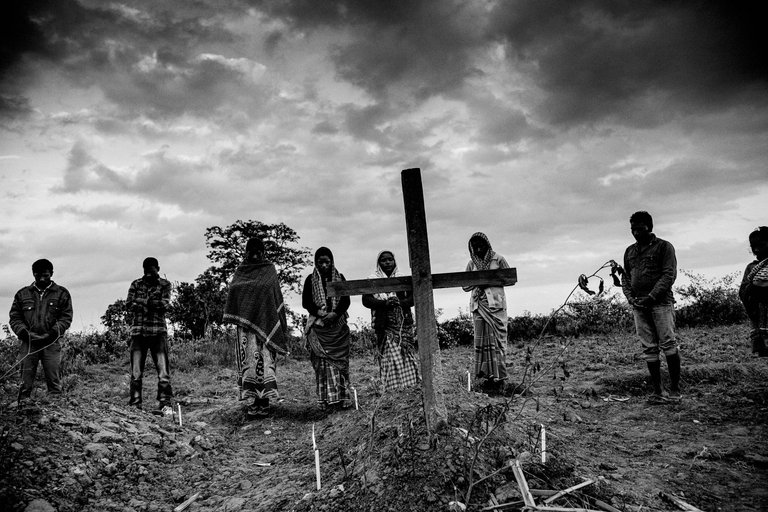
“Have you seen a tea leaf that grows higher than the bush? It gets plucked! This is exactly what the ‘Bodos’ are doing to us,” says Manik Murmu, a teacher and social worker at the Kachugaon relief camp for displaced adivasi; the attacks on the adivasis have been blamed on militants from the National Democratic Front for Bodoland-Songbijit faction (NDFB-S), deemed a terrorist organisation by the Indian Government.
Around Christmas and New Year’s day, even as the rest of the world celebrated, over 200,000 Assamese were forced into camps for the internally displaced by the violence back home. An Asian Centre for Human Rights report said over 300,000 were dislodged from their homes, terming it the largest instance of conflict-induced displacement in 2014. Families grabbed any belongings they could carry, including some livestock, so the humans in the camps are scattered among pigs, chickens, dogs and cows.
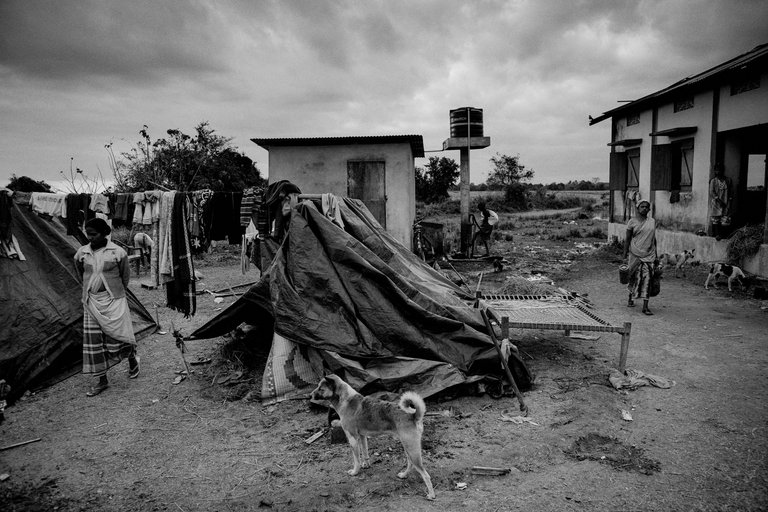 Kachugaon relief camp, Kokrajhar, Assam.
Kachugaon relief camp, Kokrajhar, Assam.
The Kachugaon Boys High School and all the open space around it has makeshift shelters built with whatever people could find — sheets of thin plastic, bedsheets, blankets and, for the lucky few, stronger plastic tarpaulin. The people here fled their villages in Kokrajhar district of Assam after militants gunned down 76 and drove thousands from their homes. State administration records say there are 12,000 people in the camp, but the camp in-charge, Philimon Mardi, puts the figure at 37,804 people displaced from 48 villages. Those who stayed back to guard the villages are counted amongst the displaced.
Inside the school building, a thin blanket spread over straw and a few small bags piled against the wall mark the spot occupied by 22-year-old Sumitra Karmakar, who fled Karikor village with her husband and four-month-old daughter. “My certificates are my life, I picked them up before I took my daughter and ran,” she says. Her eyes gleam with pride as she eagerly opens a plastic bag to show her certificates and even admit cards for exams from her school and college days.
She is pursuing a Bachelor of Arts degree at Jamduar College, 10km away at Saraibil, but has fallen behind by a year on maternity leave. Karmakar’s young family will soon have to move outside and join the people under tarpaulins, and she is ready, with a smile. “The students will have their exams soon; they need to use this place to study,” she reasons.
The NDFB-S insurgents are demanding a sovereign Bodoland for the Bodos, a tribal community indigenous to the Assam plains. This largest tribe in Assam has long been marginalised by the majority in the state. In 2003, the Indian Government partially gave in to the Bodo demand for a separate homeland — the Bodoland Territorial Area Districts (BTAD) comprising four districts north of the Brahmaputra river. The Bodos make up about 30 per cent of the population here, while the rest include Bengali Muslims, adivasis brought in by the British to work in tea gardens and logging operations, Koch Rajbongshis and other smaller groups. Currently, the NDFB-S is the only militant organisation from Bodoland engaged in violence and killings.
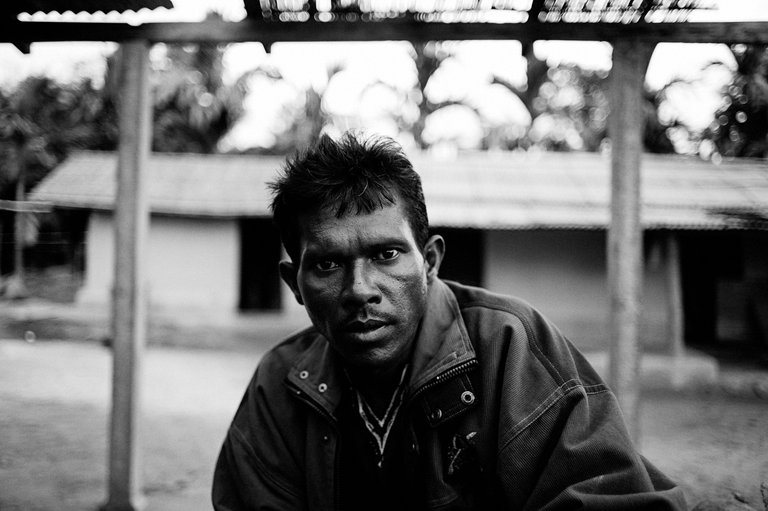 Som Hasda from Pakhriguri village.
Som Hasda from Pakhriguri village.
Som Hasda’s village, Pakhrigudi, in Kokrajhar district (about 15km from the Bhutan border), was among the four spots the militants attacked on the evening of December 23. A thin, winding road leads from the village into the jungle half-a-kilometre away. The low hills of Bhutan are behind the trees. “About 50 men armed with assault rifles walked out of the jungle and into our village,” Hasda recalls. The sun sets early in these parts and it was already dark at 5.30pm. Hasda’s 17-year-old son, Stephen, was preparing dinner, while his neighbour Andreas Murmu was cutting paper flower decorations for Christmas.
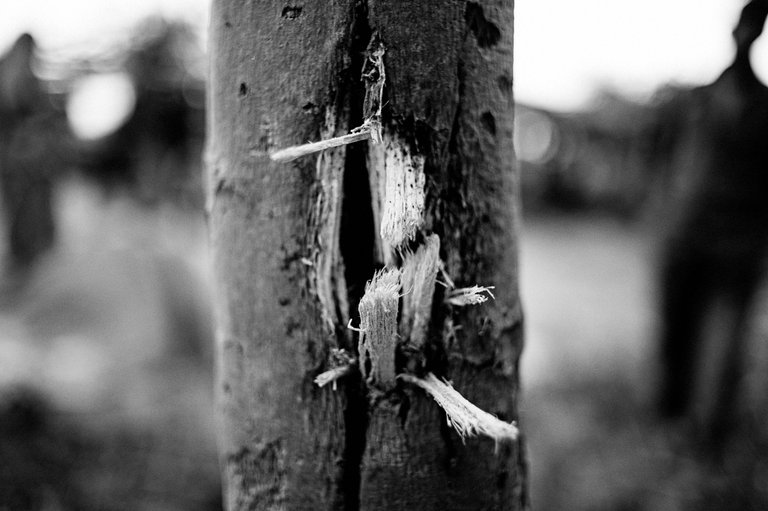 The bullet hole in the papaya tree in Som Hasda’s house.
The bullet hole in the papaya tree in Som Hasda’s house.
The men fired their guns on the unarmed villagers. As Hasda ran in panic, a bullet aimed at him pierced a papaya tree in his backyard and left a gaping hole in it. “I ran to the bed of a dried stream next to my field and sat cowering in fear,” he says. He heard the attackers laughing and calling to each other to leave the spot quickly. When Hasda returned to his tiny hut he found his son dead on the floor, the vegetables he was cutting scattered around him. Hasda’s wife Maryla Murmu was sprawled nearby, her insides hanging out. Andreas Murmu lay lifeless next to his half-cut paper flowers.
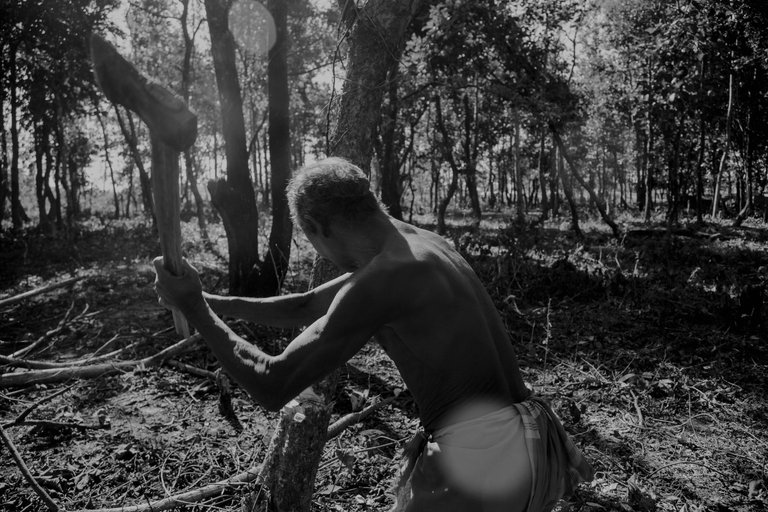
A Bodo villager chops trees for fuel.
Near Hasda’s village, Pakhriguri, there are small Bodo settlements. The Bodos and adivasis in this region eke out a simple and tough existence, sharing the shrinking resources from the forests. Both communities sell the wood they cut from the jungle to make a living.
Any violence disrupts life for both communities. Fearing for their lives, they rush into camps at schools near military outposts and police stations, where they remain trapped for years at a stretch while the militants roam free in the area as they fight the government.
Nagendro Basumatary, a 77-year-old Bodo villager from Silpur No 1 village, has seen his house burnt down twice — in 1996 and 1998. A little red satchel hanging on his side holds all the belongings he could leave home with — land documents, identity cards and letters. “I have a very small house, with one door and a window, just enough for me and my wife. If my children come to visit, they cannot even stay over,” he says, “but I built that little home with my own hands, and even when hungry I am happy there.”
Each time the homes are abandoned, they are looted and life needs to be rebuilt all over again. Given the tribals’ meagre resources, even small tools like axes, spades and farming implements take months to make or buy.
The tension between the adivasis and Bodos first started in 1996, after three Bodo girls were raped and killed in Satyapur village of Assam. The Bodos blamed adivasis for the deaths and more than 200 were killed in the violence that followed. The seeds of distrust were sown, and another incident in 1998 sparked off violence that killed over 300, both adivasis and Bodos.
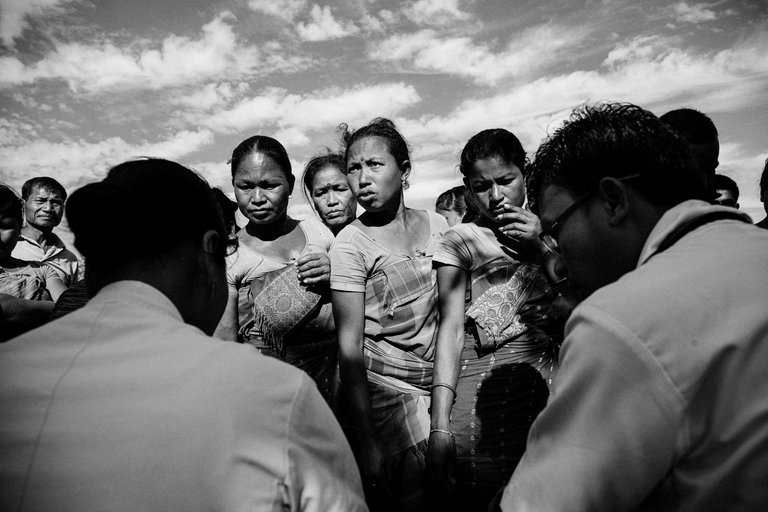 Bodo woman gather to collect relief material at a refugee camp in Kokrajhar, Assam.
Bodo woman gather to collect relief material at a refugee camp in Kokrajhar, Assam.
Militant groups like the NDFB-S have in the past trained their guns on adivasis. In 2014, the breakaway faction NDFB-S killed more than 150 people in separate incidents, including adivasis, Bengali Muslims and Hindi-speaking people. They attacked them in buses, homes and fields, and also ambushed and shot down an Additional Superintendent of Police, Gulzar Hussain in Sonitpur District.
“In the past year, 42 men from the group have been eliminated in Kokrajhar district alone, but they are a well-organised, motivated and highly disciplined lot. For every man killed, there are three more ready to take his place; we have to find a lasting solution, as killing these men using force is clearly not the answer,” says Sunil Kumar, the Superintendent of Police, Kokrajhar.
The December 2014 killings are “extremist-based violence and, barring a few stray incidents, the common public has not attacked each other like in the past,” he added.
A visit by Union Home Minister Rajnath Singh and Minister of State (Home) Kiren Rijiju the very next day and a strong statement condemning the attacks showed that the Central government was serious about reining in the banned militant group. This was followed by the Indian Army Chief’s visit to Guwahati and forward areas to review the troop deployment and counter-insurgency operations of the Indian army. A combined team of the Indian army and paramilitary forces is working with the local police to nab the militants behind the attack and keep people secure in the camps and villages.
Many Bodos feel that the adivasis have been wronged by the militants in this attack, and community leaders from both sides have helped maintain peace by making joint visits to camps and keeping the dialogue open.
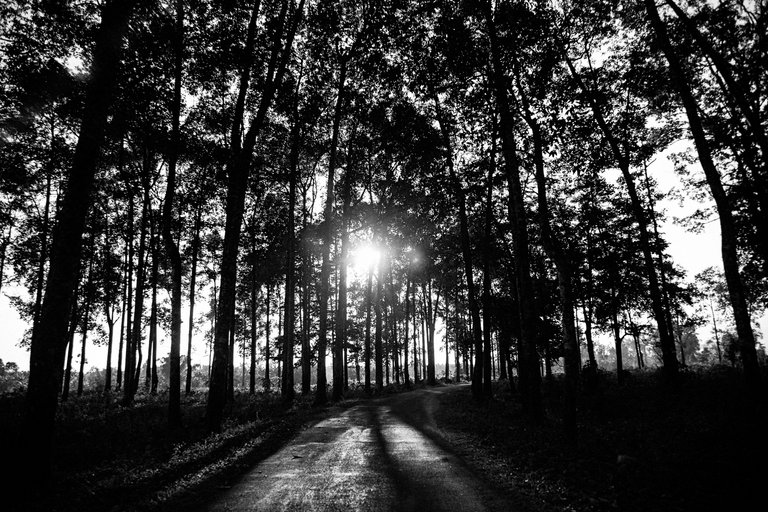 The jungles of Bodoland are a casualty in the battle for resources.
The jungles of Bodoland are a casualty in the battle for resources.
Encapsulating how the Bodos feel insecure, helpless and outnumbered in their ancestral lands, Bodo author and playwright Ashok Daimary asks, “can two kinds of rhinos live in one Kaziranga?” Hospitable and scholarly, Daimary has lived with adivasis all of his life, has close friends in the community and holds no grudges against them. But he wants to secure the way of life and future of the Bodo tribe, which he loves even more.
My driver, Kashi is a 45-year-old from Uttar Pradesh, but has lived in Bodoland all his life. Describing the Bodos’ love for their homeland, he recalls a time in the past when they even attacked people who defecated in their fields. “Hegiche toh hegiche, mutechi kyano?” (You shat here, but why did you piss on my land?)
In the Lok Sabha elections held in April 2014, to the lower house of India’s parliament, the Bodo vote was split between three candidates while a consolidation of the non-Bodo vote gave the Parliament seat to the non-Bodo, Heera Saraniya. Anticipating this, two weeks before the results were declared, the NDFB-S killed 32 Bengali Muslim men, women and children over 36 hours in Baksa, about 180km from Kokrajhar.
Everyone I spoke to — from traders, shopkeepers and the man on the street to the people in the camps — seems certain that the ethnic killings will not end anytime soon. This is just the beginning, wait for the elections to the Bodoland Territorial Council in April 2015, and the Assam state elections in 2016, they warn ominously.
Hi! I am a robot. I just upvoted you! I found similar content that readers might be interested in:
http://www.thehindubusinessline.com/blink/cover/bloodthirsty-in-bodoland/article6768240.ece
Yes, thats the same story, it was published in the HIndu Business Line newspaper, I hold the copyright.